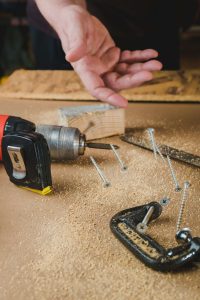Everyone has experienced the frustration of a screw becoming loose in a cabinet or piece of furniture. If you’ve ever tried to tighten it, only for it to become loose again a few days later, you know how annoying this can be.
Luckily, there are some simple steps you can take to make sure your screws stay tight and secure. Let’s break down how to keep cabinet screws tight.

How To Keep Cabinet Screws Tight: 4 Easy Ways
Tightening screws in a cabinet or piece of furniture can be an annoying and repetitive task. Fortunately, there are some simple steps you can take to make sure your screws stay tight and secure. Now, we will discuss four easy ways to keep cabinet screws tight for good.
1. Using Washers
One of the simplest and most effective ways to keep your screws tight is by using washers. Washers provide an extra layer between the wood and the screw head, which helps distribute pressure more evenly when tightening the screw. This can help ensure that the screw doesn’t loosen up over time due to uneven pressure or wear on the wood itself. You can find washers at any hardware store or home improvement center.
2. Applying Thread Lockers
Another great way to keep your screws in place is by using thread lockers. Thread lockers are special compounds that are applied directly onto the threads of the screw before insertion into the wood or metal surface it’s meant for. These compounds create an incredibly strong bond between the two surfaces, so much so that even after several years of use, they will still be firmly in place without having to be tightened again! Many different kinds of thread lockers are available, so make sure you pick one that’s best suited for your specific project.
3. Using Wood Glue
Wood glue is another popular option for keeping cabinet screws secure over time. By applying a small amount of glue around the points where you plan on inserting your screws into wood surfaces, you can ensure they won’t come loose easily.
Just make sure not to apply too much glue as this could cause damage to both the wood and screw itself if left unchecked! Also, make sure that you allow ample time for drying before attempting to use your screws in order for them to remain secure once inserted into their designated holes.
4. Using Locking Nuts
You can also use locking nuts to keep your screws in place. Locking nuts are special types of nuts that have serrated edges, which help to better grip the screw and make it nearly impossible for them to become loose over time. Again, these are available at most hardware stores and home improvement centers, so make sure to pick up the right size for your project.
Things To Consider when using the above methods
When using any of the methods above to tighten your cabinet screws, it is important to make sure that you do not over-tighten them. Over-tightening can cause damage to the screw, as well as the surrounding wood or metal surface.
It is also important to use the right size and type of screw for your particular project, as smaller screws can easily become loose over time if not properly secured.
Additionally, be sure to use the correct type of washer or locking nut for your project in order to ensure that the screw is firmly held in place.
Finally, always make sure you follow any additional instructions provided with the specific product you are using, as it may require different steps to ensure the screws remain securely tightened.
Conclusion
Keeping cabinet screws tight doesn’t have to be a hassle if you know what steps to take beforehand. By utilizing washers, thread lockers, or wood glue during the installation and assembly processes, you can ensure that those pesky little screws stay in place no matter what kind of abuse they get put through over time.
So next time you need a new cabinet installed or just need something fixed around your house; don’t forget these tips and tricks! Your cabinets (and sanity) will thank you later.

Table of Contents